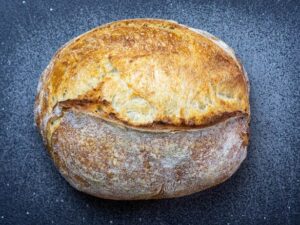

Empty nest? Here’s a baby you can burp, feed, change AND turn over to your heirs. Early Alaskans used so much of this wonderful stuff, they’re still called Sourdoughs. Start now to create an inheritance that will cost almost nothing but will enrich your family with a living, breathing presence they can nurture, share with friends, leave to their grandchildren and eat!
Like a newborn, sourdough must be kept at the right temperature, fed, burped and changed. In return it lives for years, picking up wild yeasts in your kitchen and becoming uniquely yours. As you pass it along to others, it picks up new yeast spores, morphing into another culture that is truly theirs.
Sourdough can make a new recipe every day: bread, rolls, biscuits, cookies, croissants, waffles, muffins, pizza and even chocolate cake. An Anchorage woman called Gold Nugget Morrison was famous for her Sourdough Applesauce Cake. Russian residents of Sitka ate Sourdough Donuts and Sourdough Fruitcake. Jake O’Shaughessey’s place was famous in Seattle in 1897 for its sourdough bread.
Many families are eating sourdough bread made today with cultures started by their ancestors. What a beautiful legacy to leave your grandchildren!
Make the Starter
Choose a non-metal container that has a good lid but is not airtight. (Gases form and sourdough must be allowed to burp). Starter expands, so use a 4-cup container to hold 2 cups. Scald it with boiling water to kill unwanted organisms. When it’s cool, add a teaspoon of dry yeast, two cups flour and 1 ½ cups warm water. Stir until it’s evenly moist (lumps are OK), cover with a clean dish towel, and let it stand in a warm place 48 to 72 hours until it’s tart and tangy.
Now refrigerate this starter. You’ve made two cups, one to use in a recipe and one for starting the next starter.
Let’s Bake Something
To begin any recipe, take out a cup of starter. This can be done as often as daily if you wish, but it should be done at least once every two or three weeks. Stir a cup of flour and 3/4 cup water into the remaining starter. Let it stand on the counter a couple of hours, then return it to the refrigerator.
Important Tips
Never add other ingredients to the starter. Add them later to whatever recipe you’re making.
Never dip into starter with a utensil that is not clean.
Never put leftover dough back into the pot. If starter gets green and stinky, throw it out.
Your Own Sourdough Bread
1 ½ cups warm (not hot) water
1 packet dry yeast
1 cup sourdough starter (directions above)
About 6 cups flour, preferably unbleached
2 teaspoons sugar or honey
2 teaspoons salt
½ teaspoon soda
In a big, non-metal bowl, mix the yeast and water. Stir in the starter plus 4 cups flour with the sugar, and salt. The bowl should be no more than half full to allow room for rising. Cover loosely with plastic wrap, and let rise in a warm place. It will double in bulk in two hours or less but will be sticky. Turn it out on a floured surface and work in additional flour as needed to make the dough easy to handle. Then knead 5-10 minutes until it’s shiny and stretchy. Shape into two long logs, slash tops every few inches on the diagonal and place on a greased baking sheet. Cover and let rise in a warm place until double in size. Brush tops with water and bake 45 minutes or until golden brown at 400 degrees.
Bread is just one of many delicious foods that can be made with sourdough starter. Start now to collect sourdough recipes from the Internet, cookbooks and your friends.
Janet Groene is the author of many books including Cooking Aboard Your RV, 2nd Edition.






 Related Articles & Free Subscription
Related Articles & Free Subscription
Comment here